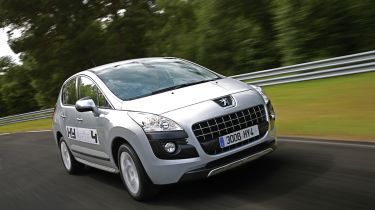Peugeot 3008 Hybrid4
We give our verdict on the world’s first diesel hybrid...

The production version of the Hybrid4 goes on sale in spring 2011, which is great news. It’s a fresh take on hybrid technology, and the four-wheel-drive car’s electric motor boosts fuel economy by a third. The electric module can be slotted into other Peugeots, so we can expect to see more of this groundbreaking development in the future.
Peugeot is ready to enter the hybrid race with a diesel-electric version of its 3008 crossover. Based on the Prologue HYbrid4 Concept, first seen at last year’s Paris Motor Show, it’s the world’s first diesel-fuelled hybrid – and we’ve had an exclusive opportunity to put an early prototype through its paces.
This car is also unique for its clever configuration. The front wheels are driven exclusively by the HDi engine, while the rear axle is turned by a small electric motor sitting where the spare wheel would normally be.
Video: watch CarBuyer's video review of the Peugeot 3008
[[{"type":"media","view_mode":"content_narrow","fid":"69246","attributes":{"alt":"","class":"media-image"}}]]
As a result, the model is economical – and four-wheel drive. As with Toyota’s Prius, the newcomer can operate in three ways: electric-only, diesel only or a combination of both.
With 200bhp and 500Nm of torque available from low revs, the Hybrid4 is no slouch, either – 0-60mph takes a most unhybrid-like 8.8 seconds.
Yet the car can return 69mpg at the pumps – a 35 per cent improvement over the diesel engine alone. And the CO2 figure is a lowly 109g/km. To make the most of the innovative set-up, there are four driving modes, selected using a dial on the centre console.
Auto picks the most efficient blend of diesel and electric power, while Sport brings in the full 200bhp. A 4WD setting shifts power between the front and rear. It can also brake the wheel with the least amount of grip, for better control on challenging surfaces. Electric-only mode runs on battery power alone.
You might be wondering why Peugeot hasn’t opted to fit this system in parallel with a smaller diesel, which would boost fuel economy even further. This is
a matter of profit margins.
The firm reckons buyers are more likely to shell out 10 to 15 per cent extra on a well specified, strong performer. However, as the technology becomes increasingly cost effective, it will filter down to cheaper models in the range.







